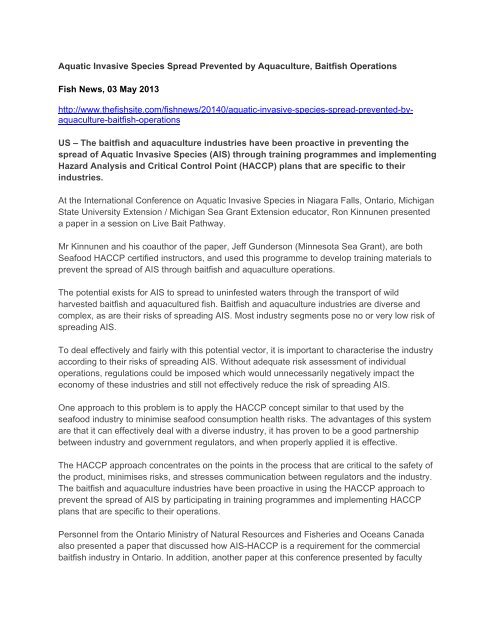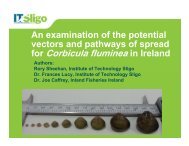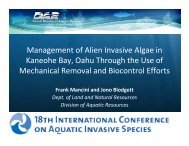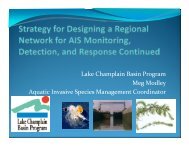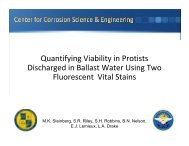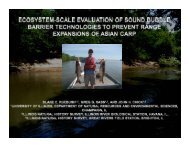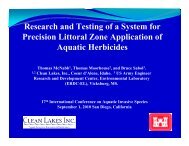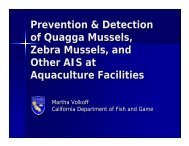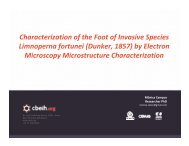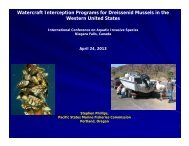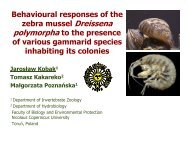Aquatic Invasive Species Spread Prevented by Aquaculture ... - ICAIS
Aquatic Invasive Species Spread Prevented by Aquaculture ... - ICAIS
Aquatic Invasive Species Spread Prevented by Aquaculture ... - ICAIS
Create successful ePaper yourself
Turn your PDF publications into a flip-book with our unique Google optimized e-Paper software.
<strong>Aquatic</strong> <strong>Invasive</strong> <strong>Species</strong> <strong>Spread</strong> <strong>Prevented</strong> <strong>by</strong> <strong>Aquaculture</strong>, Baitfish Operations<br />
Fish News, 03 May 2013<br />
http://www.thefishsite.com/fishnews/20140/aquatic-invasive-species-spread-prevented-<strong>by</strong>aquaculture-baitfish-operations<br />
US – The baitfish and aquaculture industries have been proactive in preventing the<br />
spread of <strong>Aquatic</strong> <strong>Invasive</strong> <strong>Species</strong> (AIS) through training programmes and implementing<br />
Hazard Analysis and Critical Control Point (HACCP) plans that are specific to their<br />
industries.<br />
At the International Conference on <strong>Aquatic</strong> <strong>Invasive</strong> <strong>Species</strong> in Niagara Falls, Ontario, Michigan<br />
State University Extension / Michigan Sea Grant Extension educator, Ron Kinnunen presented<br />
a paper in a session on Live Bait Pathway.<br />
Mr Kinnunen and his coauthor of the paper, Jeff Gunderson (Minnesota Sea Grant), are both<br />
Seafood HACCP certified instructors, and used this programme to develop training materials to<br />
prevent the spread of AIS through baitfish and aquaculture operations.<br />
The potential exists for AIS to spread to uninfested waters through the transport of wild<br />
harvested baitfish and aquacultured fish. Baitfish and aquaculture industries are diverse and<br />
complex, as are their risks of spreading AIS. Most industry segments pose no or very low risk of<br />
spreading AIS.<br />
To deal effectively and fairly with this potential vector, it is important to characterise the industry<br />
according to their risks of spreading AIS. Without adequate risk assessment of individual<br />
operations, regulations could be imposed which would unnecessarily negatively impact the<br />
economy of these industries and still not effectively reduce the risk of spreading AIS.<br />
One approach to this problem is to apply the HACCP concept similar to that used <strong>by</strong> the<br />
seafood industry to minimise seafood consumption health risks. The advantages of this system<br />
are that it can effectively deal with a diverse industry, it has proven to be a good partnership<br />
between industry and government regulators, and when properly applied it is effective.<br />
The HACCP approach concentrates on the points in the process that are critical to the safety of<br />
the product, minimises risks, and stresses communication between regulators and the industry.<br />
The baitfish and aquaculture industries have been proactive in using the HACCP approach to<br />
prevent the spread of AIS <strong>by</strong> participating in training programmes and implementing HACCP<br />
plans that are specific to their operations.<br />
Personnel from the Ontario Ministry of Natural Resources and Fisheries and Oceans Canada<br />
also presented a paper that discussed how AIS-HACCP is a requirement for the commercial<br />
baitfish industry in Ontario. In addition, another paper at this conference presented <strong>by</strong> faculty
from the University of Arkansas at Pine Bluff discussed how AIS-HACCP is a requirement for<br />
the Arkansas Certified Commercial Bait and Ornamental Fish Programme.<br />
Mr Kinnunen and Nick Phelps (University of Minnesota) have received notification that a<br />
proposal they submitted to the North Central Regional <strong>Aquaculture</strong> Center will be funded to<br />
conduct additional <strong>Aquaculture</strong> Biosecurity/AIS-HACCP workshops in the North Central Region<br />
of the US in the next two years.<br />
As part of this project, they will also be working with the baitfish/aquaculture industry and state<br />
regulators on exploring a third party verification program for AIS-HACCP.


